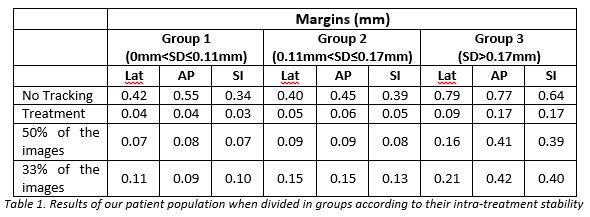Effect of intra-fraction patient stability on treatment margins in brain SRS with Cyberknife
PO-1775
Abstract
Effect of intra-fraction patient stability on treatment margins in brain SRS with Cyberknife
Authors: David Sevillano1, Juan David García-Fuentes1, Miguel Cámara1, Eva Fernández-Lizarbe2, Mercedes Martín-Sánchez2, Carolina De la Pinta2, Rafael Colmenares1, Belén Capuz1, Rafael Morís1, Felipe Orozco1, Pedro Retorta1, Pablo Galiano1, María José Béjar1, Daniel Prieto1, Feliciano García-Vicente1
1H. U. Ramón y Cajal, Medical Physics, Madrid, Spain; 2H. U. Ramón y Cajal, Radiation Oncology, Madrid, Spain
Show Affiliations
Hide Affiliations
Purpose or Objective
To
study intra-fraction residual errors occurring in brain SRS treatments with the
Cyberknife system depending on the characteristics of patient.
Material and Methods
Data from intra-fraction displacements of 70 brain
SRS patients (150 treatment fractions) treated in our department with the Cyberknife
system were analyzed in this work. Geometrical uncertainties for four different
situations were obtained: no intra-treatment tracking, real treatment and
treatment if only half and one third of the tracking images were employed. Margins
needed to account for intra-fraction uncertainties were assessed by means of
the Van Herk´s formula assuming a 70% isodose level and a beam penumbra of σp=2mm.
Margins due to rotations were calculated by assuming a mean distance between
target and imaging center of 5 cm and calculating the effect of rotations on
displacements of the target. As tumors can be isotropically distributed around
the imaging center, symmetric uncertainties were applied.
All analysis were performed for the whole
patient population and for a division of it in three groups according to the mean
standard deviation of the corrections observed during treatment.
Results
Treatment
margins for the whole patient population are 0.5mm isotropically if no tracking
is applied and 0.1 mm if residual errors of the real treatments are considered.
Margins in AP and SI directions were increased to 0.2mm when skipping the 50%
and 66% of the images, showing little dependency on imaging frequency. Results
when dividing the population according to their in-treatment motion (based on
the standard deviation of displacements) are shown in Table 1. It can be
observed that margins are much larger for the group with the most unstable
patients (group 3) than for the other 2 groups. Margins for group 3 in case no
tracking is applied are close to 1mm and almost the double than in the other 2
groups, showing the importance of identifying unstable patients when no
tracking capabilities are available. Also, margins of this last group are the
most affected when images are skipped.

Conclusion
Intra-fraction tracking is able to reduce
uncertainties of patient motion to a minimum. In case tracking is not
available, most of the patients could receive an appropriate treatment.
Nevertheless, attention should be paid to unstable patients for which tracking
might be mandatory. Also care should be taken when choosing imaging frequency
in this group of patients.